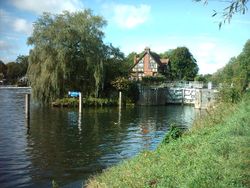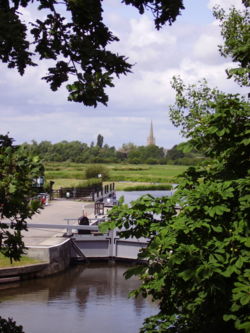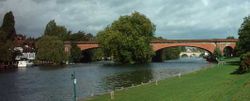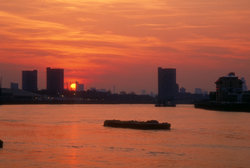River Thames
2007 Schools Wikipedia Selection. Related subjects: Geography of Great Britain
| Thames | |
|---|---|
|
|
|
| Origin | Kemble |
| Mouth | North Sea |
| Basin countries | England |
| Length | 346 km (215 mi) |
| Source elevation | 110 m (360 ft) |
| Avg. discharge | Entering Oxford: 17.6 m³/ s Leaving Oxford: 24.8 m³/ s Reading: 39.7 m³/ s Windsor: 59.3 m³/ s London¹: 65.8 m³/ s |
| Basin area | 12,935 km² (4,994 mi²) |
The Thames ( pronounced [temz]) is a river flowing through southern England, in its lower reaches flowing through London into the sea. It is one of the major waterways in England.
History
Recorded history
The Thames provided the major highway between London and Westminster in the 16th and 17th centuries. The clannish guild of watermen ferried Londoners from landing to landing and tolerated no outside interference.
In the 17th and 18th centuries, during the period now referred to as the Little Ice Age, the Thames often froze over in the winter. This led to the first Frost Fair in 1607, complete with a tent city set up on the river itself and offering a number of amusements, including ice bowling. After temperatures began to rise again, starting in 1814, the river has never frozen over completely. The building of a new London Bridge in 1825 may also have been a factor; the new bridge had fewer pillars than the old, so allowing the river to flow more freely, thus preventing it from flowing slowly enough to freeze in cold winters.
By the 18th century, the Thames was one of the world's busiest waterways, as London became the centre of the vast, mercantile British Empire. During this time, one of the worst river disasters in England took place on 3 September 1878, when the crowded pleasure boat Princess Alice collided with the Bywell Castle, killing over 640.

In the ' Great Stink' of 1858, pollution in the river reached such proportions that sittings at the House of Commons at Westminster had to be abandoned. A concerted effort to contain the city's sewage, by constructing massive sewers on the north and south river embankments followed, under the supervision of engineer Joseph Bazalgette.
The coming of rail and road transportation and the decline of the Empire, in the years following 1914, have reduced the prominence of the river. London itself is no longer a port of any note and the Port of London has moved downstream to Tilbury. In return, the river has undergone a massive clean-up, since the filthy days of the late 19th and early- to mid-20th centuries and aquatic life has returned to its formerly 'dead' waters.
In the early 1980s a massive flood-control device, the Thames Barrier, was opened. It is closed several times a year to prevent water damage to London's low-lying areas upstream (as in the 1928 Thames flood for example). In the late 1990s, the 12-km-long Jubilee River was built, which acts as a flood channel for the Thames around Maidenhead and Windsor.
Origin of the name
The river's name appears always to have been pronounced with a simple "t" at the beginning; the Middle English spelling was typically Temese and Latin Tamesis. The "th" lends an air of Greek to the name and was added during the Renaissance, possibly to reflect or support a belief that the name was derived from River Thyamis in the Epirus region of Greece, whence early Celtic tribes are thought to have migrated. However, most scholars now believe Temese and Tamesis come from Celtic ( Brythonic) Tamesa, possibly meaning 'the dark one'.
The name Isis, given to the part of the river running through Oxford, may have come from the Egyptian goddess of that name but is believed to be a contraction of Tamesis, the Latin (or pre-Roman Celtic) name. Richard Coates has recently suggested that the river was called the Thames upriver, where it was narrower and Plowonida down river, where it was too wide to ford. This gave the name to a settlement on its banks, which became known as Londinium, from the original root Plowonida (derived from pre-celtic Old European 'plew' and 'nejd,' meaning something like the flowing river or the wide flowing unfordable river).
Geography
Course
The Thames has a length of 346 km (215 miles). Its usually quoted source is at Thames Head (at grid reference ST980994), about a mile north of the village of Kemble and near the town of Cirencester, in the Cotswolds. However, Seven Springs near Cheltenham, where the river Churn rises, is also sometimes quoted as the Thames' source, as this location is furthest from the mouth both in distance along its course and as the crow flies. The springs at Seven Springs also flow throughout the year, while those at Thames Head are only seasonal.
The Thames then flows through Lechlade, Oxford, Abingdon, Wallingford, Reading, Henley-on-Thames, Marlow, Maidenhead, Windsor, Eton, Staines and Weybridge, before entering the Greater London area.
The river itself rises in Gloucestershire, traditionally forming the county boundary, firstly between Gloucestershire and Wiltshire, between Berkshire on the south bank and Oxfordshire on the north, between Berkshire and Buckinghamshire, between Berkshire and Surrey, between Surrey and Middlesex and between Essex and Kent. Before the 1974 boundary changes, the current boundary between Berkshire and Surrey was between Buckinghamshire and Surrey. The Oxfordshire - Berkshire boundary was also moved at that time.
The area to the west of London is normally called the Thames Valley, whilst east is called Thames Gateway.
Catchment area and discharge
The whole of the river drains a catchment area of some 12,935 square km (4,994 square miles) or 15,343 square km (5,924 square miles) if the River Medway is included as a tributary.
The non-tidal section
Innumerable brooks, streams and rivers, within an area of 9948 square km (3,841 square miles), combine to form 38 main tributaries feeding the Thames between its source and Teddington. These include the rivers Churn, Leach, Cole, Coln, Windrush, Evenlode, Cherwell, Ock, Thame, Pang, Kennet, Loddon, Colne, Wey and Mole.
Between Maidenhead and Windsor, the Thames supports an artificial secondary channel, known as the Jubilee River, for flood relief purposes.
More than half the rain that falls on this catchment is lost to evaporation and plant growth. The remainder provides the water resource that has to be shared between river flows, to support the natural environment and the community needs for water supplies to homes, industry and agriculture. During heavy rainfall events the Thames occasionally receives raw sewage discharge due to sanitary sewer overflow.
The tidal section
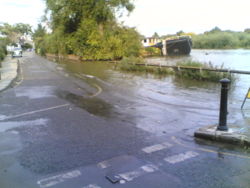
About 90 km from the sea, at Teddington, the river begins to exhibit tidal activity from the North Sea. This tidal stretch of the river is known as "the Tideway". London was reputedly made capital of Roman Britain at the spot where the tides reached in AD 43 but this spot has moved up river, in the 2000 years since then, because of the glacial rebound effect. At London, the water is slightly brackish with sea salt. Below Teddington, the principal tributaries include the rivers Brent, Wandle, Effra, Westbourne, Fleet, Ravensbourne (the final part of which is called Deptford Creek), Lea, Darent and Ingrebourne.
The average discharge of the Thames grows up to approximately 66 m³/s (cumecs) at the end of its non-tidal section, at Kingston upon Thames, a figure which is exceeded by some other British rivers (e.g., the Severn and the Tay). Indeed, if the Thames were not a tidal river, its average discharge in the centre of London would be somewhere between 80 and 100 m³/s, and the Thames would look like a small river, not the large river we can see today by Westminster, the Houses of Parliament or the City.
Some low-lying areas beside the tidal section of the Thames are liable to regular flooding at spring tides. However, in recent years, the flooding has been occurring more frequently at unusual times. One such example exists at Chiswick Lane South in London's W4 postal district, where the river now bursts its banks almost daily between March and September.
Navigation
The Thames is navigable from the estuary as far as Lechlade in Gloucestershire. Between the sea and Teddington Lock, the river forms part of the Port of London and navigation is administered by the Port of London Authority. From Teddington Lock to the head of navigation, the navigation authority is the Environment Agency.
The river is navigable to large ocean-going ships as far as the Pool of London and London Bridge. Today little commercial traffic passes above the docks at Tilbury and central London sees only the occasional visiting cruise ship or warship, moored alongside HMS Belfast and a few smaller aggregate or refuse vessels, operating from wharves in the west of London. Both the tidal river through London and the non-tidal river upstream are intensively used for leisure navigation.
There are 45 locks on the River Thames. See Locks on the River Thames for a full list of all locks.
Crossings
The river is crossed by many bridges and tunnels. Famous crossings of the Thames include:
- Dartford Crossing
- Thames Barrier
- Blackwall Tunnel
- Rotherhithe Tunnel
- Thames Tunnel
- Tower Bridge
- London Bridge
- Millennium Bridge
- Hungerford Bridge
- Westminster Bridge
- Maidenhead Railway Bridge
- Marlow Bridge
- Windsor Railway Bridge
See Crossings of the River Thames for a full list of all crossings.
Islands
Famous islands in the Thames include:
- Isle of Sheppey
- Canvey Island
- Isle of Grain
- Eel Pie Island, Twickenham
- Magna Carta Island, Runnymede
- Fry's Island, Reading (sometimes known as De Montfort Island)
See Islands in the River Thames for a full list of all islands.
Ecology-Biology
Culture
Literature
The Thames is a motif in many books. Three Men in a Boat by Jerome K. Jerome describes a boat trip up the Thames; published in 1889, it has never been out of print, proof of the continuing influence of the Thames on the literary imagination. Other authors took inspiration from this best-selling comic novel (with its side-nods to social commentary). Examples include poet Kim Taplin's 1993 travelogue Three Women in a Boat and Connie Willis's To Say Nothing of the Dog. Somewhere near the Oxford stretch is where the Liddells were rowing in the poem at the start of Alice's Adventures in Wonderland. The river is almost a character in its own right in Kenneth Grahame's The Wind in the Willows and its derivatives. The utopian News from Nowhere is mainly the account of a journey through the Thames valley in a socialist future.
In books set in London there is Sherlock Holmes looking for a boat in The Sign of Four. Many of Charles Dickens's novels feature the Thames. Oliver Twist finishes in the slums and rookeries along its south bank. Our Mutual Friend begins with a scavenger and his daughter pulling a dead man from the river, to legally salvage what the body might have in its pockets. Dickens opens the novel with this sketch of the river, and the people who work on it:
In these times of ours, though concerning the exact year there is no need to be precise, a boat of dirty and disreputable appearance, with two figures in it, floated on the Thames, between Southwark Bridge which is of iron, and London Bridge which is of stone, as an autumn evening was closing in.
The Thames also features prominently in Philip Pullman's His Dark Materials trilogy, as a communications artery for the waterborne Gyptian people of Oxford and the Fens.
In poetry, T.S. Eliot references the Thames at the beginning of The Fire Sermon, Section III of "The Waste Land".
In Heart of Darkness by Joseph Conrad, the old sailor Marlow begins his yarn while sitting on a boat in the Thames. The serenity of the contemporary Thames is contrasted with the savagery of the Congo River, and with the wilderness of the Thames as it would have appeared to a Roman soldier posted to Brittania two thousand years before. Conrad also gives a memorable description of the approach to London from the Thames Estuary in his essays The Mirror of the Sea (1906).
Sport
Rowing and sailing are the main sports which take place on the River Thames, though punting and skiffing also take place; unlike the 'pleasure punting' common on the Cherwell in Oxford and the Cam in Cambridge punting on the Thames is competitive and uses narrower craft. There are many clubs which encourage participation in these sports and organise racing and inter-club competitions. Kayaking on the River Thames is also popular, with sea kayakers using the tidal stretch for touring, and whitewater playboaters surfing Hurley Weir and Boulter's Weir.
Rowing
The Thames is the historic heartland of rowing in the United Kingdom. There are over 200 clubs on the river, which make up 40% of the membership of the Amateur Rowing Association. Most towns and districts of any size on the river have a club, but key centres are Oxford, Henley-on-Thames and the stretch of river from Chiswick to Putney.
Clubs notable for their size, history or success include (travelling downstream):
- Wallingford Rowing Club
- Leander Club, Henley on Thames
- Upper Thames Rowing Club, Henley on Thames
- Marlow Rowing Club
- Weybridge Rowing Club
- Molesey Boat Club
- Kingston Rowing Club
- Twickenham Rowing Club
- Mortlake Anglian & Alpha Rowing Club, Chiswick
- Tideway Scullers School, Chiswick
- Furnivall Sculling Club, Hammersmith
- Auriol Kensington Rowing Club, Hammersmith]]
- Thames Rowing Club, Putney
- London Rowing Club, Putney
Notable university clubs include (travelling downstream):
- Oxford University Boat Club
- Oxford University Lightweight Rowing Club
- Oxford University Women's Boat Club
- Oxford University Women's Lightweight Rowing Club
- Oxford Brookes University Boat Club
- Reading University Boat Club
- University of London Boat Club
- Imperial College Boat Club
Notable school clubs include (travelling downstream):
- Headington School Boat Club
- Radley College Boat Club
- St Edward's School Boat Club
- Eton College Boat Club
- Windsor Boys School Boat Club
- Lady Eleanor Holles School Boat Club
- Hampton School Boat Club
- St Paul's School Boat Club
- Westminster School Boat Club
- King's College School Boat Club
Two rowing events on the River Thames are traditionally part of the wider English sporting calendar:
The University Boat Race is rowed between Oxford University Boat Club and the Cambridge University Boat Club in late March or early April, on the Championship Course from Putney to Mortlake in the west of London.
Henley Royal Regatta takes place over five days at the start of July in the upstream town of Henley-on-Thames. Besides its sporting significance the regatta is an important date on the English social calendar alongside events like Royal Ascot and Wimbledon.
Other significant or historic rowing events on the Thames include the Head of the River Race and other head races over the Championship Course, Henley Women's Regatta, the Wingfield Sculls, Doggett's Coat and Badge, the Henley Boat Races and the Oxford University bumping races known as Eights Week and Torpids. Innumerable other regattas, Head races and bumping races are held along the Thames.
Sailing Clubs on the non-tidal river
(in order downstream)
- Medley Sailing Club - Oxford
- Abbey SC - Abingdon
- Goring Thames SC
- Henley SC
- Marlow SC
- Upper Thames SC - Bourne End
- Cookham Reach SC
- Staines SC
- London River Yacht Club - Kingston-upon-Thames
- Desborough SC - Shepperton
- Weybridge SC
- Aquarius SC - Hampton
- Hampton SC
- Thames SC - Surbiton
- Tamesis Club - Teddington
- Ariel Sailing Club - Teddington
Trivia
- The Sex Pistols played a concert on the Queen Elizabeth Riverboat on June 7, 1977, the Queen's Silver Jubilee, while sailing down the river.
- On January 20, 2006, a northern 16-18ft (5m) bottle-nosed whale was spotted in the Thames and was seen as far upstream as Chelsea. This is extremely unusual because this type of whale is generally found in deep sea waters. Crowds gathered along the riverbanks to witness the extraordinary spectacle. But it soon became clear there was cause for concern, as the animal came within yards of the banks, almost beaching, and crashed into an empty boat causing slight bleeding. Approx. 12 hours later, the whale was believed to be seen again near Greenwich, possibly heading back to sea . There was a rescue attempt lasting several hours, but it eventually died on a barge. See River Thames whale.
- Amongst unusual objects floated along the Thames include a Eurostar Railway locomotive, a Concorde aircraft and a U boat Submarine.
- It is not unusual to see the French navy in the Thames, very often French naval vessels make official visits to the Royal Navy dock, HMS President, just by the Tower Bridge.
- While writing in his diary in June 1667 Samuel Pepys was disturbed by the sound of gunfire, as Dutch warships on the Thames broke through the Royal Navy to invade London.
- Polar explorer and endurance swimmer Lewis Pugh became the first person ever to swim the length of the River Thames. His journey started on 17th July 2006 close to the source of the river in Gloucestershire and ended 147 miles later in London. Pugh undertook the challenge to raise awareness of climate change.
- At various times there have been claims that angels have been sighted over the river.
Religion
When a Roman Catholic converts to Anglicanism, that person is said to have "swum the Thames". The reverse is referred to as "swimming the Tiber".



